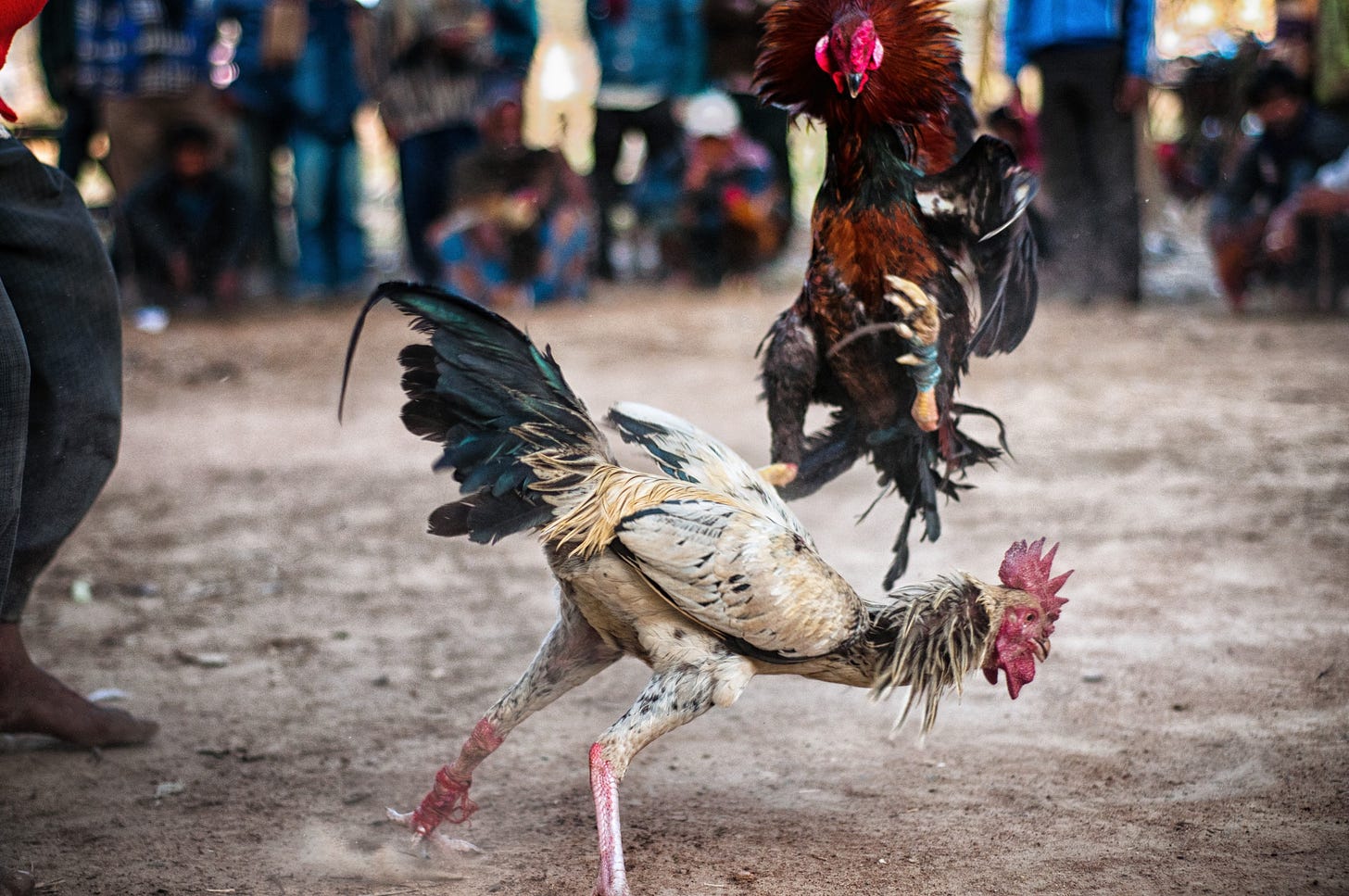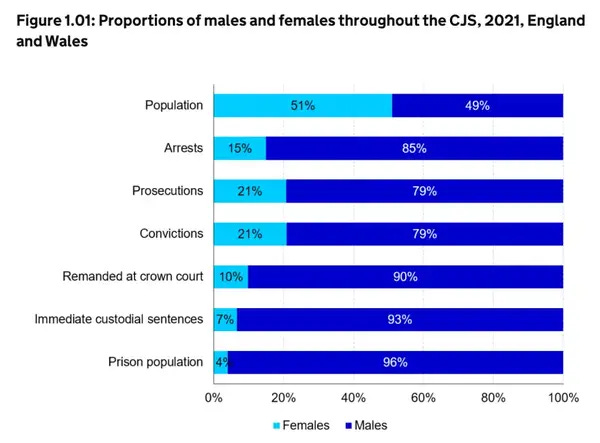On the Nature of Women
How subduing the biological maternal instinct of women averted a population explosion
“I have given suck, and know how tender ‘tis to love the babe that milks me” - Lady Macbeth
In my last article I addressed the accelarationist frustration that we as a society don’t build, and began my explorations of how controlled economic self-sabotage since the 1970s has averted a Malthusian population crisis. Looking upon much of the feedback which the article generated, it struck me that the article’s most frequent criticism pertained to the views expressed on sexual behavioral differences. Many intelligent readers took strong issue with my claim that women are innately, and not culturally, predisposed to strongly want children, more so than men.
Specifically, by far the most disputed passage in my previous post was the following:
“I am often struck by how broody many women are from an evolutionary perspective. Despite the significant risk placed by giving birth to a woman’s life, many of the most neurotically minded women that I know are absolutely obsessed with having children and satiating their craving for cuteness.”
Many objected that this was anecdotal, and it’s true the evidence provided in that article, for the sake of brevity, was anecdotal; this article aims to address this by making the case for an innate broodiness in women from a sound theoretical and evidential basis. It will lay the ground work for future posts examining how subduing the maternal instinct in women has significantly reduced the global fertility rate and averted a population explosion. While it is instrumental to society that mythologies of the cultural nature of behavioral femininity are maintained, it is important to disabuse the intelligent readers that this blog aims to convince of this carefully constructed myth.
To disprove this myth let’s first dismantle the idea that there could be no innate behavioral difference between men and women.
Consider the hypothetical where you are an alien observer of planet earth on the evening before the birth of the first Homo Sapien 100,000 years ago. You have been collecting data on all of earth’s animal species that have existed up to that point; you have no indication yet that this new species will come to dominate the planet with it’s unprecedented intelligence and power of cultural mimesis.1 With what probability would you, alien, estimate that there would be no behavioral differences between the two sexes of this new species?
Philip Tetlock puts forward several techniques used by super-forecasters to make predictions about the future. One of these techniques is the outside-view question:
“How often do things of this sort happen in situations of this sort?”2
So let’s consider what proportion of animals have differences in their sexual behavior? Bluntly, most of them do.3 Cockerels are more aggressive than chicken; bulls more aggressive than cows; and, male dogs are more aggressive than female4, to provide some examples. Taking this as the naive base case, you as alien in our hypothetical, should predict a high probability that there will be behavioral differences between male and female humans.
Charles Darwin observed this pattern of different behaviors between the sexes in most species as far back as 1871.5 The most convincing theory explaining this is the Darwin-Bateman paradigm that predicts that anisogamy - the fact that females produce fewer but larger gametes, whereas males produce more and smaller gametes - generates numerous sex-specific adaptations in morphology, physiology and behavior. Darwin himself noted that females tend to be choosier than males about whom to mate with, a pattern that can be observed today in women6. Subsequently A. J. Bateman demonstrated in fruit flies that male reproductive success is more variable and increases more steeply with the number of mates.7
A simple abstract mathematical model can illustrate how anisogamy creates a trade-off that, through natural selection, leads to behavioral differences between the sexes. Consider a fictional species of animals called Homo Viridis. Members of the Homo Viridis species can give birth to at most one baby at a time. Both parents then have a choice, whether or not to care and support their new born baby for its first few nascent years, when it’s physically and mentally undeveloped, and thus much less likely to survive than an adult Homo Viridis. Child support could take the form of feeding and providing shelter for the baby, for instance. Let’s suppose that without child support from either parent the offspring of a baby Homo Viridis has a 1% chance of reproducing and passing on its genes, but, that with child support, from either parent, that rises to 25%. Since the female sex is restricted in how many gametes she can produce in a given time period, let’s suppose that she has one window of viable fertility each month. Also, if the female gets pregnant and provides parental support they then become infertile for two years, whereas if they get pregnant and don’t provide child support they are infertile for only one year. Conversely, let’s assume, the male sex could fertilize up to one female gamete a day, but if they get a female pregnant and provide child support they’re also infertile for two years, perhaps they’re so busy providing child support they don’t have time to find sexual partners. They lose no fertility if they don’t provide child support. Both sexes have only ten years in their lifetime in which they are fertile, and, for the sake of a simple model, all other partners are flighty and will not offer child support.
Let’s consider first our female Homo Viridis; if she maximizes her fertility and provides no child support she will have a maximum of 10 children each with a 1% chance of reproducing. The probability that at least one child successfully reproduces is slightly less than 10%.8 If instead she maximizes her fertility while providing child support to all of her offspring she will have a maximum of 5 children each with a 25% chance of reproducing. With this strategy there is nearly a 77% chance that at least one of her offspring reproduces.
Now let’s consider our male Homo Viridis; if he maximizes his fertility and provides no child support he will have the maximum of 3650 children, the probability that at least one of these children reproduce is greater than 99.9999999999%. Whereas, if he maximizes his fertility while providing child support to all of his offspring there is a smaller 77% chance that at least one of his 5 offspring reproduce. Already it is evident that there will be selection pressures for males to have different reproductive behavioral strategies with regards to females. In this case females are significantly more likely to proliferate their genes if they provide child support to their offspring, while males are more likely to proliferate if they choose not to provide child support and successfully engage in a strategy of promiscuity.
We can also illustrate the effect of mate choice with a small amendment to our model. Assuming that there are high value sexual partners that can increase the chance of any given offspring reproducing to 50%, with child support; but, that for both sexes it takes an entire month to find and evaluate the value of a sexual partner, and they then only conceive at the end of that month. The qualities of these high value mates could be above average strength or intelligence, for instance. In this case for both sexes with a strategy of looking for high value mates, and providing child support the chances of producing at least one offspring that reproduces is approximately 97%.
In this simulation over many generations there will be strong selection pressures for females to provide child support and to be selective in their choice of partner, but for males there will be, albeit smaller, selection pressures to pursue strategies of maximal indiscriminate fertilization while providing no child support. Note, that if we assume females are not flighty, and will always provide parental support, the male strategy of being flighty leads to even higher probabilities that at least one offspring will reproduce.
“Sex roles have been defined as ‘conventional’, when females are choosier than males, and males are more likely than females to compete for mating opportunities.”9
Thus, we can see that due to the differing effects on the sexes’ inter-generational reproductive chances, afforded by different strategies along the insemination-nurturing trade-off, there is a theoretical basis for the observed pattern that most species exhibit some differing behaviors. Specifically, different behaviors around mate choice and level of child care, between the opposite sexes, with much greater levels of child care offered by the female sex, supporting the Darwin-Bateman paradigm of strong innate maternal behaviors in women.
One may object that by considering all species for our naive base case we’re under-fitting our predictive model, and that we should assign greater weight in our predictive model to those species that are genetically most similar to humans. Here we arrive at the heart of the intellectual underpinning for the mythology of the social construction of human sexual behavioral differences.10 The two most closely related species to humans are bonobos and chimpanzees.11 There are clear differences in behavior between chimpanzees of the opposite sex, who as a species are highly patriarchal12; but, much is made of the much smaller differences in the behavior of the sexes and the matriarchal nature of bonobos.
“[B]onobo males are commonly subordinate to females and do not compete intensely for dominance rank. They do not form alliances with one another and there is no evidence of lethal aggression between groups.”13
Note, however, the matriarchal nature of bonobos is itself illustrating a behavioral difference between female and male bonobos. So even in this supposedly “self-domesticating”14 and matriarchal species we observe sexual differences in behavior, and thus even in our closest evolutionary relatives there is behavioral sexual dimorphism.
Next we must dismantle the idea that humans are a unique species on account of being the only species to have developed complex cultures allowing for the adoption of non-innate behaviors. At its most extreme this is a belief that humans start life as “blank slates” and that any “gendered” behavioral differences are learnt behaviors attained through a patriarchal culture.15
Pavlov was famous for demonstrating learnt behavior in species,16 but, what is more incredible are innate behaviors. Recently I spent time in the countryside with some family whose cat had just given birth to a litter of kittens, they gave most of the kittens away except for two. The two they kept had spent their first six months exclusively indoors with their mother, and had only then started to go outside on leashes (they live on a farm). On the first day they were let out I was sitting outside with the kittens on their leashes and a stranger adult cat came within 5 meters of the kittens. Both kittens immediately started shaking, put their tales between their legs, and made themselves very small. It cannot be stressed just how incredible this phenomenon is. Inside the brains of these kittens is an assembly of proteins into brain cells that encode the behavioral response: see stranger cat that is bigger than me → fearful cat response.
Similarly humans have many innate impulses; one such drive is an inherent need for self-improvement and growth.17 This drive can often be diverted, in men and boys this is often done with video games. It is hard to pin down human drives as they are often obfuscated by humans deceiving themselves, and others, using plausible excuses; often culture facilitates this by providing acceptable excuses that provide plausible deniability for our most culturally undesirable drives and instincts. For example, you and a friend encounter a celebrity; your friend is so keen to impress this celebrity that they dominate the conversation and don’t allow you to speak. You challenge them about this and they deny that they did this, their strength of conviction is such that you come to appreciate that they most likely did not realize that they were blocking you out of the conversation. While motivations, conscious and subconscious, are difficult, or often impossible, to prove, it would take a position of extreme philosophical skepticism to deny that the majority of people are motivated by at least some innate human drives, such as the desire not to be hungry.
The question then, is there a baby fever drive in humans and does it affect the female sex more than the male?
“It had come over me quite suddenly, in my mid-twenties, when I was working for Vogue, a tidal surge. Once this surge hit I saw babies wherever I went. I followed their carriages in the street. I cut their pictures from magazines and tacked them on to the wall next to my bed. I put myself to sleep by imagining them: imagining holding them, imagining the down on their heads, imagining the soft spots at their temples, imagining the way their eyes dilated when you looked at them.”18
The above passage from the American journalist Joan Didion’s 2011 autobiography captures the feeling of this urge. It beautifully corroborates our expectation from the Darwin-Bateman paradigm that a member of the female sex will have a strong urge to nurture their offspring. Suspending disbelief about which sex possesses this urge most strongly, it also vividly illustrates the power of the urge in people to want babies for the sake of babies.
To answer the question of whether this urge afflicts women more than men it is important to first consider the obstetrical dilemma in humans. The obstetrical dilemma is the trade-off between having smaller birth canals in mothers, which facilitates the ability to walk upright, and babies having relatively big heads compared to other species to facilitate intelligence.19 Humans because of their large heads have high maternal mortality rates relative to other species20; the natural maternal mortality rate without the use of modern medicine is estimated to be around 1.5%.21 To put that into context that implies that a mother who gave birth three times would have nearly a 5% chance of dying in childbirth and a mother who gave birth ten times, common in prehistoric times22, and in early modern times23, would have nearly a 15% chance of dying in childbirth. Even if like the burgeoning feminist academic complex, one disputes the obstetrical dilemma,24 one must admit that our maternal ancestors will have been acutely aware of the dangers of childbirth. As such, there will have been strong selection pressures for genes in prehistoric women that created a powerful drive to have babies that overcame any anxieties, given the universally higher level of neuroticism in women25, and the high maternal mortality rate.
Can we observe this drive and urge in people today, and can we observe it more strongly in women? A collection of people’s anecdotal reports suggests an ambivalent picture26 and at least one recent survey found the opposite, that men want children more27. No doubt, this will convince many that women are not naturally more broody than men. However, a study of over 10,000 people from 79 countries found significant gender differences in desire for a child, with women having higher personal desire for a child.28 A study of Australian women found “[m]ost women had fewer children than they desired, and many would have children, or more children, if their circumstances were different.”29 The economist Lyman Stone collected the results of surveys of American women all the way back to the 1960s and found that women consistently report ideal family sizes greater than replacement fertility rate.30
Regardless, we should remember that one of the human species’ strongest drives is that of self deception, to make it easier to deceive our fellow tribe members about our unpalatable desires.31 As the old adage goes, watch what people do, not what they say.
Above is a screenshot of comments from a popular channel of YouTube family vloggers.32 Perusing the comments on many33 of the family34 vloggers35 on YouTube36 one would notice this pattern consistently. The commenters on family vlogging YouTube are disproportionately female. Women are significantly more likely than men to give up their time comment on, and most likely watch, on this content. Readers are encouraged to browse the YouTube comments of the channels linked in the references above to corroborate this for themselves, and, at the very least, to explore a side of YouTube that many readers of this blog will likely have never encountered before.

It is also instructive to look at the extremes of human behaviors. Just like many physical characteristics, human behavioral tendencies will vary along some spectrum, and often the statistical distributions of the characteristics will differ by sex. Just like the distribution of heights, a physical characteristic, differ in men and women, so does the frequency of aggressive incidents, a behavioral characteristic.
Many women will go as far as buying unregulated sperm on the black market to impregnate themselves.37 There are also incidents of women becoming addicted to having babies. Few external links will be linked in this blog without a footnote, but, this link on incidents of baby addiction in women is so indicative that an exception will be made.
While the current book of psychiatric diagnoses, the “Diagnostic and Statistical Manual of Mental Disorders,” has no entry on baby addiction, mental-health professionals say they see patients, mostly women, who desperately want to keep having newborns, even when they already have several children and aren’t managing their family situation well.
While the article notes that this addiction can come out of the anxiety and depression that was the result of dysfunctional childhoods, two things are notable. The first, that the afflicted are “mostly women”; assuming that men and women are equally likely to have dysfunctional childhoods (which admittedly could be mistaken), the predominance of the affliction in women can only be a function of their nature. The second, that the sufferers of this affliction, again mostly women, find that it is baby fever that distracts them sufficiently from the negative emotions that they’re feeling, which is suggestive of the strength of this drive. Thus, the tail-end of the statistical distribution for baby fever in women is highly likely to be further to the right along the spectrum of intensity of baby fever than the distribution of baby fever in men. Therefore, it is likely, although not certainly, the case that the entire distribution, including the averages, of baby fever in women is to the right of the distribution in men.
Similarly, women also show differences in their responses to cuteness. A study showed that women gave significantly higher “liking” ratings to infant faces, but not adult faces, than men. It also found that women spent more time looking at photos of infant faces than men.38 This makes sense in the light of theories of cuteness being an emotional response that cements a bond between child and parent, and that, by the Darwin-Bateman paradigm, women have much stronger incentives than men to provide parental support.39 To deny that women are more interested in families and babies and more maternal than men is akin to burying one’s head in the Eiffel Tower of sand dunes.
It is clear then that there is a sound theoretical and evidential basis for the claim that women have a much stronger drive to have babies than men. But, what of the role of culture? What if it is a consequence of the cultural indoctrination of the patriarchy that women feel “baby fever” more than men.
While not all feminist theorists are blank slate theorists, and so may admit to some biological differences in behavior, although what those are is hard to pin down.40 Ultimately the proponents of blank slate feminist theories of patriarchal cultural indoctrination must admit to one innate human drive, that of mimesis. The argument goes that young girls learn what is expected from a woman, and feel pressure to perform as a woman. However, this “performativity”, as Judith Butler would put it, contradicts their blank slate theories of humanity.41 To perform according to expectations presupposes an expectation, i.e. an observed pattern of behavior in a group; such a pattern, if not the result of innate behavior, must be the result of imitation. On the canvas of the blank slate of our nature our behavior is etched on by the fulfillment of the expectations of others given our gender, so the theory goes. However, such imitation can only be the result of a mimetic drive, or some other drive that brings about imitation, in humans; otherwise, the behavior of each individual, if not mimetic and not predetermined by biology, could only be random and thus no pattern could form and no such gender expectations could exist. Therefore, humans can’t be complete blank slates in terms of behavior as they must have at least one innate drive, the drive to imitate or a drive that compels imitation.
If humans must have at least one innate behavior, then it is feasible that they would have others. Furthermore, while the blank slate extreme is obviously false, it is clear that, similarly, the opposite extreme that all human behaviors are innate is also false; otherwise, human civilization would be one big monoculture. In fact, it is the human capacity for mimesis that makes our species so powerful. For natural selection makes the adoption, by a species, of new beneficial behaviors a slow process that must take place over many tiny iterations that happen over many generations; imitation, in contrast, allows us to expedite this process by imitating the, most likely, successful practices of high status humans, where status is a proxy for wealth.42 In the beginning of the agricultural revolution, a forager could amass a surplus of food by imitating a farmer. Likewise, today an aspiring teenager can significantly increase their potential for future income by imitating the clean code practices of a software engineer. Instead of waiting the many millions of years to evolve new beneficial behaviors that would increase the likelihood of any given organism successfully reproducing, imitation often allows us to quickly gain these skills in our own lifetimes. This explains the tendency for people to have role models, anyone imitating the behavior of someone with a large command of resources would be more likely to also gain a large command of resources and be more likely to have survivable offspring.
Given different contexts, successful strategies worth imitating will differ. Someone imitating a pineapple farmer in the Victorian era will likely have much better outcomes in Brazil than in Norway. This goes some of the way to explaining why cultural practices may differ from one society to another. For culture is nothing but the mass imitation of particular, seemingly successful or identity defining, behaviors.
It is likely that many cultural practices are the result of random circumstance; someone survives a disease after making a particular prayer, and this prayer is mass adopted. Some cultural practices may perform well in a particular context due to the path dependence caused by the adoption of some other random cultural practice; someone randomly dies after a woman loudly wishes misfortune for them, the society adopts a culture of witch-hunting, suddenly it is beneficial for women to perform some practice demonstrating their opposition to witchcraft. These behaviors have less to do with optimizing some exploitation of the physical world and more to do with avoiding ostracism or impressing others to increase one’s own status, which is also important for accruing resources.
So what then is the balance between innate behaviors and cultural practices. It is most likely impossible to quantify. Most likely it is the case that cultural practices that don’t run counter to any innate impulses are easy for individuals to pick up. Sports are attractive to most men as they offer opportunities to practice physicality, which was often necessary to protect and acquire resources in our evolutionary past, and also to acquire status through rank and skill. Healthy diets are much harder to adopt as they run counter to our “donut drive”, an innate craving for densely caloric foods that would provide large amounts of energy in the food scarce environments of our evolutionary past. Despite this healthy diets can be adopted, but only with much effort in the struggle not to act on the impulses brought about by our “donut drive”. Similarly there will also be uncomfortable cultural practices that will not provide such, prima facie, clear and obvious benefits. Getting a tattoo or piercing can often be painful and can in rare circumstances lead to infection, despite this people will overcome their discomfort to attain the increased status in certain social circles from having a tattoo or a piercing.
Today many women claim not to want children, no doubt there will be some women where this lack of desire is real. Some will have been put off by anxieties about the planet’s future, others will be so driven by ambition in their careers to have been put off completely from having children, and there are some, either from repression or chance, who don’t feel any baby fever at all. The cultural practices of western women today are different to those of the 1950s. By mimesis, western women’s ambitions have been directed to pursuing careers and enjoying travel in their most fertile ages. Similarly, their expectations of their male partners have increased43 , and women are settling on partners to have children with at much later ages, increasing the chance of failure to have children from natural fertility decline with age. In the most delicious irony, the contemporary “performativity” of women is to act, against their nature, more and more like men. However, many women of fertile age, in many different countries including the west, report feeling a state of tension between their desire to pursue a career and to have children. This is indicative of an innate drive in women that is being suppressed. Freud observed that the root of many mental disorders is the inherent tension that arises from repressing desires. Much like a dieter finds it difficult to suppress their “donut drive”, similarly the suppression of baby fever is not painless for most women; however, while painful, just as we all must bear our own burdens, some greater than others, a world without sufficient distractions from baby fever is ultimately not sustainable.
Disclaimer: This blog intends to start a monthly discourse with accelerationists on the virtues of realistic ecological conservatism. The ideas that will be discussed are incendiary and may inflame some tempers. As such, in the future once I have started to gain a following I intend to guard my posts behind a paywall. For now, I’m offering readers the opportunity to subscribe at a discounted rate.
https://www.amazon.co.uk/Cognitive-Gadgets-Cultural-Evolution-Thinking/dp/0674980158/
https://goodjudgment.com/philip-tetlocks-10-commandments-of-superforecasting/
https://kelleylab.biology.columbia.edu/sites/default/files/content/lab%20papers/annurev.ne_.11.030188.001301.pdf
https://pmc.ncbi.nlm.nih.gov/articles/PMC6162565/
Charles Darwin (1871), The Descent of Man and Selection in Relation to Sex. London: Murray
https://www.americansurveycenter.org/newsletter/the-gender-divide-in-dating-expectations/
https://www2.nau.edu/~shuster/shustercourses/BIO%20698/Literature/Bateman1948.pdf
Since the probability that any one offspring does not reproduce is 0.99, the probability that they all don’t reproduce is 0.99^10. The probability then that at least one reproduces is 1 - 0.99^10.
https://onlinelibrary.wiley.com/doi/10.1111/brv.12915
https://en.wikipedia.org/wiki/Amy_Parish
https://pmc.ncbi.nlm.nih.gov/articles/PMC3498939/
https://pmc.ncbi.nlm.nih.gov/articles/PMC3904494/
https://pmc.ncbi.nlm.nih.gov/articles/PMC3498939/
https://www.sciencedirect.com/science/article/abs/pii/S000334721100546X
https://academic.oup.com/book/9175/chapter-abstract/155802984?redirectedFrom=fulltext
https://en.wikipedia.org/wiki/Classical_conditioning
https://econtent.hogrefe.com/doi/full/10.1027/1016-9040/a000294
Joan Didion (2011), Blue Nights. Alfred A. Knopf, Inc.
The feminist academic complex has already started outputting research disputing the obstetrical dilemma. This article explains the dilemma and responds to feminist criticisms. https://pubmed.ncbi.nlm.nih.gov/34013651/
https://pmc.ncbi.nlm.nih.gov/articles/PMC8518115/
https://motherhoodinprehistory.wordpress.com/2015/12/04/how-many-mothers-died-in-childbirth/
https://cordis.europa.eu/article/id/430411-neolithic-mothers-and-the-survival-of-the-human-species
“A half-starved Highland woman frequently bears more than twenty children” - Adam Smith (1775), Wealth of Nations. Penguin Random House
https://undark.org/2017/11/29/obstetrical-dilemma-hips-risk-childbirth/
https://www.researchgate.net/publication/14018323_Gender_Differences_in_Extraversion_Neuroticism_and_Psychoticism_in_37_Nations
https://www.reddit.com/r/TwoXChromosomes/comments/1aerldz/in_your_experience_are_men_as_or_more_likely_to/?sort=top
https://www.pewresearch.org/short-reads/2024/02/15/among-young-adults-without-children-men-are-more-likely-than-women-to-say-they-want-to-be-parents-someday/
https://pmc.ncbi.nlm.nih.gov/articles/PMC6282098/
https://link.springer.com/article/10.1007/s12546-011-9072-3
https://medium.com/migration-issues/how-big-is-the-fertility-gap-in-america-fd205e9d1a35
Kevin Simler, Robin Hanson (2020), The Elephant in the Brain. OUP.
https://www.youtube.com/@KnorppandSouth11
https://www.youtube.com/@OurTribeofMany
https://www.youtube.com/@jonathanjoly
https://www.youtube.com/@ThePiggottFamily
https://www.cosmopolitan.com/uk/reports/a42150608/inside-the-fertility-black-market/
https://journals.plos.org/plosone/article?id=10.1371/journal.pone.0020632
https://www.sciencedirect.com/science/article/abs/pii/S1364661316300420
https://www.torch.ox.ac.uk/article/one-is-not-born-but-becomes-a-woman
http://www2.kobe-u.ac.jp/~alexroni/IPD2020/IPD2020%20No.2/Salih-Butler-Performativity-Chapter_3.pdf
https://www.amazon.co.uk/Cognitive-Gadgets-Cultural-Evolution-Thinking/dp/0674980158/
https://www.sheebamagazine.com/article/family-relations/the-evolution-of-womens-expectations-from-romantic-partners-over-the-decades/











